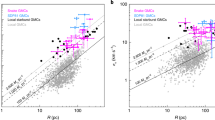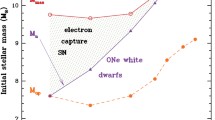Abstract
A stochastic model has been developed to study the hierarchical fragmentation process of young massive clusters in external galaxies considering close binary components along with individual ones. Stellar masses for individual ones have been generated from truncated Pareto distribution and stellar masses for close binary components have been generated from a truncated Bi-variate Gumbel Exponential distribution. The above distribution is identified by fitting the observed bi-variate distribution of masses of eclipsing binary stars computed from the light curves catalogued in the package Binary Maker 3.0. The resulting mass spectra computed at different projected distances, show signature of mass segregation. Degree of mass segregation becomes reduced due to the inclusion of binary fraction. This might be due to the reduction of massive stars and inclusion of less massive stars rather than inclusion of single massive stars and the effect of line of sight length projected to an observer.








Similar content being viewed by others
References
Abt, H.A.: Annu. Rev. Astron. Astrophys. 21, 343 (1983)
Allison, R.J., Goodwin, S.P., Parker, R.J., de Grijs, R., Portegies Zwart, S.F., Kouwenhoven, M.B.N.: Astrophys. J. 700, L99 (2009)
Arenou, F.: AIP Conf. Proc. 1346, 107 (2011)
Ascenso, J., Alves, J., Lago, M.T.V.T.: Astron. Astrophys. 495, 147 (2009)
Bate, M.R.: Mon. Not. R. Astron. Soc. 363, 378 (2005)
Bellazini, M., Fusi Pecci, F., Messineo, M., Monaco, L., Rood, R.T.: Astron. J. 123, 1509 (2002)
Bradrstreet, D.H., Steelman, D.P.: Bull. Am. Astron. Soc. 34, 1224 (2002)
Brandner, W., Clark, J.S., Stolte, A., Waters, R., Negueruela, I., Goodwin, S.P.: Astron. Astrophys. 478, 137 (2008)
Burgasser, A.J., Reid, I.N., Siegler, N., Close, L., Allen, P., Lowrance, P., Gizis, J.: Protostars and Planets V, p. 427 (2007). arXiv:astro-ph/0602122
Chattopadhyay, A.K., Kanjilal, T., Basu, B.: Syst. Anal. Model. Simul. 43, 1697 (2003)
Chattopadhyay, T., Chattopadhyay, A.K., Sinha, A.: Astrophys. J. 736, 152 (2011)
Chattopadhyay, T., De, T., Warlu, B., Chattopadhyay, A.K.: Astrophys. J. 808, 24 (2015)
Chavarria, L., Herpin, F., Jacq, T., the WISH consortium: Astron. Astrophys. 521, L37 (2010)
Cool, A.M., Bolton, A.S.: Publ. Astron. Soc. Pac. 163, 177 (2002)
de Grijs, R., Anders, P., Zackrisson, E., Ostlin, G.: Mon. Not. R. Astron. Soc. 431, 2917 (2013)
Delfosse, X., Beuzit, J., Marchal, L., Bonfils, X., Perrier, D., Ségransan, D., Udry, S., Mayor, M., Forveille, T.: ASPC Conf. Ser. 318, 166 (2004)
Dib, S., Kim, J., Shadmehri, M.: Mon. Not. R. Astron. Soc. 381L, 40 (2007)
Duchene, G., Beck, A.K., Twin, P.J., de France, G., Curien, D., Han, L., Beausang, C.W., Bentley, M.A., Nolan, P.J., Simpson, J.: Nucl. Instrum. Methods Phys. Res., Sect. A 432, 90 (1999)
Duchene, G., Bontemps, S., Bouvier, J., Andre, P., Djupvik, A.A., Ghez, A.M.: Astron. Astrophys. 476, 229 (2007)
Duquennoy, A., Mayor, M.: Astron. Astrophys. 248, 485 (1991)
Elmegreen, B.G., Clemens, C.: Astrophys. J. 294, 523 (1985)
Elmegreen, B.G., Mathieu, R.D.: Mon. Not. R. Astron. Soc. 203, 305 (1983)
Espinoza, P., Selman, F.J., Melnick, J.: Astron. Astrophys. 503, 801 (2009)
Figer, F.D., Kim, S.S., Morris, M., Serabyn, E., Rich, R.M., McLean, I.S.: Astrophys. J. 525, 750 (1999)
Fischer, D.A., Marcy, G.W.: Astrophys. J. 396, 178 (1992)
Geller, A.M., de Grijs, R., Li, C., Hurley, J.R.: Astrophys. J. 779, 30 (2013)
Geller, A.M., de Grijs, R., Li, C., Hurley, J.R.: Astrophys. J. 805, 11 (2015)
Genest, C., Ghoudi, K., Rivest, L.P.: Biometrica 82, 543 (1995)
Goodwin, S.P., Kroupa, P.: Astron. Astrophys. 439, 565 (2005)
Goodwin, S.P., Kroupa, P., Goodman, A., Burkert, A.: In: Reipurth, V.B., Jewitt, D., Keil, K. (eds.) Protostars and Planets, p. 133. University of Arizona Press, Tuscon (2007)
Gumbel, E.J.: J. Am. Stat. Assoc. 292, 698 (1960)
Halbwachs, J.L., Mayor, M., Udry, S., Arenou, F.: Astron. Astrophys. 397, 159 (2003)
Harayama, Y., Eisenhauer, F., Martins, F.: Astrophys. J. 675, 1319 (2008)
Hodge, P.W.: Astrophys. J. 249, 384 (1961)
Hu, Y., Deng, L., de Grijs, R., Goodwin, S.P., Liu, Q.: Astrophys. J. 724, 649 (2010)
Hurley, J.R., Aarseth, S.J., Shara, M.M.: Astrophys. J. 665, 707 (2007)
Kouwenhoven, M.B.N.: Ph.D. Thesis, University of Amsterdam (2006). astro-ph/0010792
Kroupa, P., Tout, C.A., Gilmore, G.: Mon. Not. R. Astron. Soc., 262, 545 (1993)
Kroupa, P., Petr, M.G., McCaughrean, M.J.: New Astron. 4, 495 (1999)
Lada, C.J., Lada, E.A.: Annu. Rev. Astron. Astrophys. 41, 57 (2003)
Lada, C.J., Margulis, M., Dearborn, D.: Astrophys. J. 285, 141 (1984)
Larson, R.B.: Mon. Not. R. Astron. Soc. 161, 133 (1973)
Li, C., de Grijs, R., Deng, L.: Mon. Not. R. Astron. Soc. 436, 1497 (2013)
Marsh, K.A., Kirkpatrick, J.D., Plavchan, P.: Astrophys. J. 709, 158 (2010)
Milone, A.P., Piotto, G., Bedin, L.: Astron. Astrophys. 540, 16 (2012)
Moeckel, N., Bonnell, I.A.: Mon. Not. R. Astron. Soc. 396, 1864 (2009)
Moeckel, N., Clarke, C.J.: Mon. Not. R. Astron. Soc. 410, 2799 (2011)
Pasquato, M., Trenti, M., DeMarchi, G., Gill, M., Hamilton, D.P., Miller, M.C., Stiavelli, M., van der Marel, R.P.: Astrophys. J. 699, 1511 (2009)
Portegies Zwart, S.F., McMillan, S.L.W., Gieles, M.: Annu. Rev. Astron. Astrophys. 48, 431 (2010)
Robert, C.P., Casella, C.: Springer, New York (1998)
Romani, R.W., Weinberg, M.: Astrophys. J. 372, 487 (1991)
Rubenstein, E.P., Bailyn, C.D.: Astrophys. J. 474, 701 (1997)
Sagar, R., Kumar, B.: ASI Conference Series 4, 113 (2012)
Sagar, R., Richtler, T.: Astron. Astrophys. 250, 324 (1991)
Sagar, R., Subramaniam, A.: Rev. Mex. Astron. Astrofís., Ser. Conf. 8, 93 (1999)
Salpeter, E.E.: Astrophys. J. 121, 161 (1955)
Sánchez-Salcedo, F.J., Chametla, R.O.: Astrophys. J. 794, 167 (2014)
Sanner, J., Geffert, M.: Astron. Astrophys. 370, 87 (2001)
Verschueren, W.: Astron. Astrophys. 234, 156 (1990)
Voyez, J.: Tech. rep., Stage de Licence 3 Parcours Magistère, Université Paris Diderot (2008)
Wolf, M., Vladimir, V.: Astrophys. Space Sci. 128, 229 (1986)
Zhao, B., Bailyn, C.D.: Astrophys. J. 129, 1934 (2005)
Acknowledgements
The first author wishes to thank the Department of science and Technology (DST), India for awarding her a major research project for the work. The authors are very grateful to the referee for valuable suggestions for the improvement of the work to a great extent.
Author information
Authors and Affiliations
Corresponding author
Appendix: Simulation from Pareto distribution
Appendix: Simulation from Pareto distribution
Simulation from Pareto (i.e. truncated power-law) distribution is done by using the inverse transformation method for pseudo-random number sampling i.e. for generating random samples from the probability distribution given its cumulative distribution function (cdf). According to this method, one requires to uniformly sample a number \(u\) between 0 and 1, interpreted as a probability, and then return the largest number \(x\) from the domain of the distribution \(p(X)\) such that \(p(-\infty < X < x)\le u\). According to the probability integral transformation, if \(X\) is a continuous random variable with cumulative distribution function \(F_{X}\), then the random variable \(Y=F_{X}(X)\) has a uniform distribution on \([0, 1]\). The inverse probability integral transform is just the inverse of this: specifically, if \(Y\) has a uniform distribution on \([0, 1]\) and if \(X\) has a cumulative distribution \(F_{X}\), then the cumulative distribution function of the random variable \(F_{X}^{-1}(Y)\) is \(F_{X}\). In \(C11\), the authors found out the total mass of the proportion of fragment masses in the regime \(m_{\min}\leq m\leq m_{c}\) to the regime \(m_{c}\leq m\leq m_{\max}\) is divided approximately in the ratio \(10:90~\%\). In this paper, we have taken appropriate choice of proportion of total mass for the different regime in case of individual fragment simulation and for the \(50~\%\) individual fragments, we have simulated fragment masses from a power-law distribution, whose cdf is given by:
We equate the above to \(u\) when \(u\sim U(0,1)\) to obtain
Now for different values of \(\alpha\) (as obtained from viz. Table 2), we get fragment masses for the different segment regimes.
The method of generating samples of stellar masses from a segmented power law (truncated Pareto distribution) is as follows:
Let
where \(A\) and \(B\) are constants which are determined from continuity and normalization conditions (Chattopadhyay et al. 2015). \(m_{\min}\) and \(m_{\max}\) are taken from C11. We take the help of conditional distribution to generate samples from the above power laws in the following way:
Let
In the same manner we define,
We use the method of inversion to draw samples using these two conditional cdfs. e.g. for \(m_{\min} < m \le m_{c}\), we draw a random sample say \(u_{1}\) from a Uniform distribution, i.e., \(U(0,1)\)
So that inverting it we get the expression for the sample m as
Thus when \(u_{1}=0\), \(m=m_{\min}\) and when \(u_{1}=1, m=m_{c}\). Similarly, for \(m_{c} < m \le m_{\max}\).
We simulate from \(F_{1}(m)\) as long as half of the total stellar mass of the embedded cluster is equal to 10 % of the efficient mass of the parent cloud and then simulate from \(F_{2}(m)\).
Rights and permissions
About this article
Cite this article
Chattopadhyay, T., Sinha, A. & Chattopadhyay, A.K. Influence of binary fraction on the fragmentation of young massive clusters—a Monte Carlo simulation. Astrophys Space Sci 361, 120 (2016). https://doi.org/10.1007/s10509-016-2705-4
Received:
Accepted:
Published:
DOI: https://doi.org/10.1007/s10509-016-2705-4




